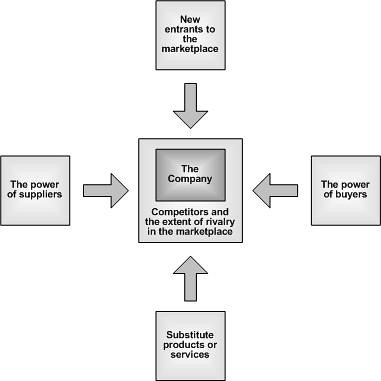Tool: Five-Forces analysis
Topic: Business Architecture (TOGAF phase B)
When an Enterprise Architect is asked to develop or change an IT strategy for a company, something important has changed. Organizations do not embark upon such an expensive, and potentially high-impact, process unless compelled by some event, and it’s important that you, as the Enterprise Architect, find out what that change is.
It is not enough to assume that it’s a matter of timing or personality (e.g., “the company just hired a new CIO and she wants an architecture”) because they may just be symptoms. You need to seek the actual cause and that will be, or should be, an event that has made an impact on the business itself or that the senior leaders anticipate may happen. In fact, if you find that it isn’t, and it’s just the whim of a senior leader with a bit of spare cash, then you start at a disadvantage, because no one else will care about your work or support your proposals.
Michael Porter developed a useful tool, known as the Five Forces model, for understanding the pressures acting upon a business and, more important, what has changed. I use it all the time and thoroughly recommend it.
Essentially, the model analyses the forces acting upon a company within the context of its industry. The aim is to understand the drivers of each force and their respective strength. A change to either may be driver that has caused the need for Enterprise Architecture work.
Porter segments the various forces into five categories: competition, product substitution, the power of suppliers, the power of customers, and new entrants to the market.
To understand the model, think of a cake. The cake represents all the money that can be made in an industry or market segment (e.g., PC sales). You are developing an Enterprise Architecture for one of the businesses that sells products or services to earn a slice of that cake, and their business strategy aims to get a bigger slice every year. However, there are five forces preventing the company get all of the cake:
- The extent and nature of competitive rivalry: Businesses change their prices, introduce new products or start to promote their products differently, in an effort to take a larger slice of the cake.
- The threat of substitutes: There are other products or services that might prove to be more attractive and which drain away some of the money to be made in a market segment, thereby reducing the overall size of the cake.
- The ease of entry to the industry: Newcomers see a chance to take a slice of the cake by using skills or products they have developed in a similar market segment. Unless they bring something new to the market that increases the overall size of the cake, then one or more of the existing players has to suffer.
- The power of buyers: The value of the cake comes from the customers who buy the products or services being created and those customers will constantly seek to change the balance of power (meaning the price per unit they pay) in their favour. Common techniques that buyers employ include purchasing in larger volumes, playing suppliers off against each other, and building the product themselves.
- The power of suppliers: The products that are manufactured, and the services that are delivered, earn the money represented by the cake. These product and services rely, in turn, upon other raw materials or services that are provided by suppliers. These suppliers can exert pressure on a company by increasing prices or reducing product quality.

So, how does this model help you as the Enterprise Architect?
First, when you interview the senior leaders of the organization, to gain an understanding of the business, your questions should cover these five forces. Talk to the marketing director about changes in customer habits (i.e., the demand side) and the effect that product promotions are having on the marketplace. Talk to the procurement director about equivalent changes in the supply chain. Talk to sales about innovations they see arriving in the marketplace and new competitors that have entered. Most important, ask them what has changed and what they think your enterprise architecture can do about it.
To learn about a technique I use to fully understand a business, please click here.
Second, once you’ve discovered what has changed, before you dive in and announce what IT should do to help the company respond to the change, take a step back for a moment. Envision what kind of organization would thrive and survive best in these new circumstances. Companies die from a thousand cuts, constantly making minor adjustments in response to market conditions without understanding the new marketplace. It may be time to do things entirely differently. Enterprise Architects have to envision the best solution as well as the minimum solution. The business case for each must calculate the switching costs (from the current state to the future state) and weigh them against the benefit. This is where you discover how important it is, that other people care about your work and support your proposals, because you’ll need their help when developing the business cases.
Finally, understand that, as Enterprise Architect, you are responsible for:
- Creating economies of scale which provide a cost advantage to the business that it can use to tease ‘share of cake’ away from competitors.
- Raising barriers to entry that make it harder for rivals and potential competitors from entering the marketplace. Technology can produce excellent barriers to entry, whether it be the best-in-industry web site, world-class customer relationship management or a patented widget.
- Introducing innovation that can differentiate products and services, creating a price advantage to the business. So, researching and embracing new technologies is an important part of the role.
- Making decisions that improve the organization’s status with respect to the five forces. A typical mistake that IT departments make is allowing themselves to be drawn into using technologies that are only available from one company. The power of suppliers is clearly greatest where there is no substitute product or service available, or where a product becomes essential to the company. Only technologies that can be purchased from multiple suppliers should be considered, except those that help the company differentiate itself in the marketplace. By the way, this rule explains (and justifies) the rise of open standards, since openness fundamentally alters the balance of the five forces to a position more favourable to the buyers of IT services at the expense of the suppliers.
Blogger:

1 comment:
Wow, another great detailed blog leveraging Michael Porter's ideas – thank you!
In my opinion, Michael Porter's 1985 book, "Competitive Advantage," with its frameworks for corporate planning and for performing an industry analysis, represents the blueprint and solution for any company to bridge the gap between business and IT.
Post a Comment